GIANT 5Ds META POST #1--Peruvian Zombie Cults Ahoy!
Because I have been promising a ton of people I would do these for a really long time.
There will actually be several of these, with different posts covering different kinds of nerdery. For those who wonder, the only reason this is going up before the GX stuff is that I already had these ones partially written up, from a forum. However, this version is largely exanded. And will continue to expand as I find more crap that I made notes about but promptly forgot upon losing interest in the show.
Also bear in mind that I am by no means a 5Ds expert! I have not watched all of the first season (I consider this the series start through the end of the Dark Signer arc), and seen about...four episodes of the current season, two of which are this week and last week and one of which was the totally random filler 'driving class' episode. So if I have a series fact grossly wrong, or have missed something that should be glaring obvious, please tell me! Also feel free to ask about anything. This will also not be all-inclusive. For example, I know Divine calls Aki his 'Jeanne d'Arc', and I know there's a Daedalus/Icarus thing going on, but I'm going to assume everyone catches those. They're not exactly obscure.
Oh yeah, and this has spoilers. Lots and lots of spoilers. Also PICSPAM.
Section 1:
First things first--Vocabulary!

Signer (rough pronunciation 'sigu-na' in the show) vs the Quechua 'Siq'u nana' (rough pronunciation siKu-nana; very hard k with a glottal 'g' roll, very similar sound), which would be 'Driven By the Mark'. Y/N?
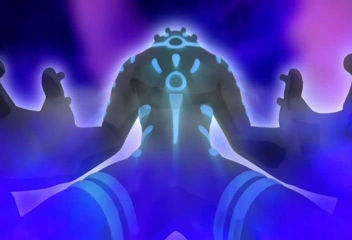
'Ccapac Apu' means, loosely, 'virtuous king', and he is in fact named after Apu Ccapac, an Incan emperor who greatly united the tribes of Peru early on. This also however refers to the line of 'pure inca' descended from him, who ruled along with their closest family and inner circle. Anyone who was not a member of this group, or attempted to root ideals or methodology in the incan society contrary to this, was either exiled or brutally killed. Dissatisfied with the way other quarters of the empire were running, they moved systematically through the areas of the empire, killing off the ruling families in them and taking their place while miraculously seeming to take no casualties themselves along the way. However, these restless Ccapac eventually spread themselves too thin, and were destroyed by dissention and miscommunication within their own ranks.
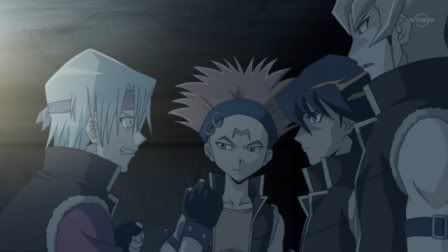
Why yes, I do believe we've heard this story before.
In 5Ds, the monster Ccapac Apu is of course the glyph of the 'man'. While many new-age morons call this the 'astronaut', tribal people of Peru call it either the 'giant' (as he is dubbed in 5Ds) or 'traveller'. In the creation myth of Wiraqutra, the first life he created on earth were great stone giants without eyes or mouths, who wandered aimlessly over the lands. Because they displeased him, he destroyed them and started again. 'The Giant' (I prefer 'traveller', myself) is also one of the glyphs the Nazca people had in common with their delightful neighbors, the Moche and their decapitator cult. In both cases he is seen as a warrior and leader; in both cases he is also one of the guardians of the gate into the underworld (in which role he's also a bit of a showman and artist). It is believed that he calls up the damned from hell into the eyes of the images and statues all about him.

Well we definitely don't have anything like that, so let's move on.
I have heard that something about Kiryu as a 'death god' comes up in Crash Town. Not having actually watched the arc I don't know, but yes, this would make that not an entirely innacurate statement.
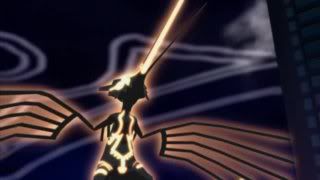
Aslla Piscu has the most delightful name ever. Though Quechua has a perfectly good word for 'hummingbird' (qu'enti or kinti, if you're wondering), this means 'little crow'. However, it can also be translated as 'little penis', leading to some SERIOUSLY. EPIC. LULZ. This one is not named for incan royalty, but rather a meddlesome spirit who tampers with human hearts and relationships--further evidence of the theory that Penis Ruins Everything.
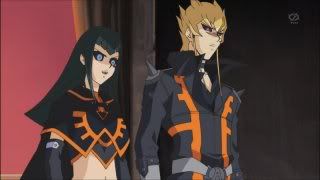
That's a big ol' "check".
Among the Moche, the hummingbird was one of their war gods, responsible for bringing back prisoners to be sacrificed on the altars. Among the Nazca and Inca, hummingbirds were considered 'sun creatures'. Like all small birds in Peruvian mythos, they were believed able to revitalize and ressurect themselves at will, moving freely between life and death. Their dead bodies were carried to help one find success in love. However, a live hummingbird in your doorway is a bad omen, which means that a distant loved one has passed away (such as, say, by being chucked out a window). As for 'little crows', the 'head' god (lololol) of the Moche decapitator cult was attended by small black birds who flew in and out of his mountain lair as his messengers; these were his links between heaven and earth. Interestingly, fish and birds were considered to be largely the same creatures, as the sea and sky were joined. Which is why, should you ever use that ridiculous 'a fish might love a bird, but where would they live?' comment while vacationing in Peru, you would probably receive an odd look.
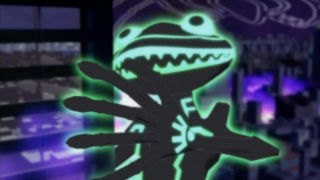
Ccaryhua is quechua for 'iguana'. Of the two lizard glyphs on the Nazca pampas, they actually use the smaller, more slender lizard--the gecko or anole--rather than the big clunky 'iguana'. Though this spelling is the least common, it IS closest to that of Ccarahua, a member of the incan royal family. Very little is known about her; she is said to have died shortly after her younger brother and otherwise did little of historical note.

Check.
In most peruvian mythology, including that of the Nazca and Moche, the lizard is not party to any particular godhood; instead, they take on the role of 'divine shrine attendants', always in twin pairs. The iguana specifically, however, accompanies the god of burial, and were themselves sometimes charged with leading processions of the dead, or guiding the living to their dead loved ones. Some believed that the iguana would lead them, if followed, to the killer of a family member who died under mysterious circumstances.

Justice Lizard successfully strikes again!
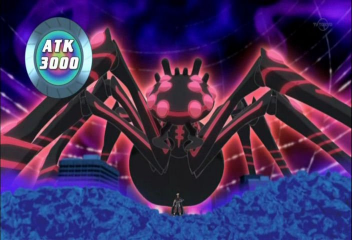
Uru is Quechua for, quite simply, 'spider'. Among the Moche, this was one of the greatest gods of the subterranean decapitator cult as one of the favored forms of its 'head' god (I need to stop doing that); their very ritual practices, which involved binding and the long-term bleeding of a sacrificial victim over as many days or weeks as possible, rather than an immediate sacrifice, are inspired by the behavior of the spider. The spider's many arms were used not only to hold the ritual knives, but also to allow it to better manipulate the world around it. Even in more benevolent forms, as among the Inca, the spider is a manipulator--when Kon, the creator of the world in the previous cycle, went after the twin children of the 'creator' who had taken his place, the spider tricked him into climbing up the mountain to look for them, from whence he fell through a chasm into the spider's lair and died hideously. The twins were later made into the sun and the moon. Many believe the story of Kon and and his later, rival god is an allegory for the conflict between the coastal Moche/Wari--who became part of the Incan Empire--and the upland Nazca/Paracas--who did not. In this comparison, it should surprise no one that Kon is associated to the Nazca, and the moche keep their headhunter. Though seen as the 'villain' of this Incan story, earlier mythology cites Kon as a benevolent creator and a being of light who nurtured life and fertile growth in the valleys of Peru. Even when he took the rain away from the Nazca for turning on him, he still granted them rivers, that they might drink and not suffer. This both says something about the Incan bias and also spiders. Fucking spiders always kill the nice ones.
'Uru' is also Ayamara for 'dawn'. It is also the name of a tribe who speaks the ayamara language; this tribe believes that the gods, the kings, and all the secrets of civilization came from the stars. Their ancient kings, before they were conquered and absorbed by the Inca, spoke with a great god in the stars, who imparted to them the way the land would be ruled. The Uru live on man-made islands, and are one of the few tribes remaining active in the world today. So apparently their 'star kings' told them something right.
I actually skipped several (ie, most) of Rudger/Uru's episodes, so if many references to the actual mythology are made, I probably missed them. I do know however that Rudger's use of the little 'rape spiders' early in the cultist arc, as well as the throwing out of Rally into the first duel with Yusei, is in keeping with the spider's role as manipulator of the world at large. Also, that he tricked Bommer into coming back for some reason involving children then dropped him in a pit to his death. Fucking spiders.
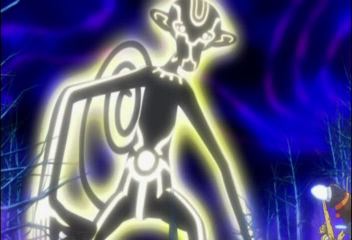
Cusillu comes from the Quechuan 'k'usillu', which means both 'monkey', and 'fool'. I suppose it could be 'qusilu', which has a similar pronunciation and means 'clear-eyed man', or 'one who sees clearly'. Historically, this Earthbound God shares its name with a great warrior-shaman, whose fighting style lives on to this day and among the Ayamara has lent the word a third meaning (great warrior). Sadly, I know little of him beyond the fact that he apparently was really good at kicking ass. Despite the fact that its name is frequently used as an insult, the monkey in mythology was seen as shaman himself, sometimes a king, renowned for his cunning and cleverness. Though not appearing in the Moche decapitator pantheon, it shares a role with the Giant in their culture--the monkey guards the side of the gate between worlds opposite to his eyeball-fetishing artsy brother. If one wishes to speak with those trapped in the earth, one must go through this fuzzy shaman.
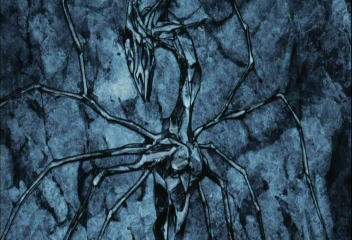
Such as dessicated dragon-fairies.
Yeah, I skipped these episodes too.
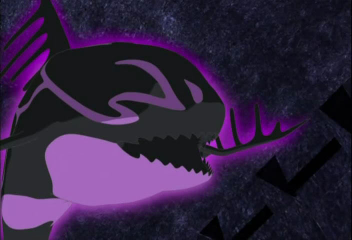
Chacu Challua, the baby-eating whalegod! One of my favorite of the moche decapitator crew. I've heard it suggested that this is from 'chuqi challwa', which is a kind of small fish in Peru (literally, 'little golden fish'). I have my doubts. For the whale god I suspect Ch'ak (blue sky) and chaku (hunting) are both equally more likely candidates for the first part; challa (sand) ch'allu (ripe) ch'alla (drinking) all compete for the second ('hunting drinking' would be indicative of great hunger and constant consumption, a trait of the represented god; 'blue sky sand' would cover the orca's perceived hunting grounds; ie, anywhere the fuck it wanted). Most likely of all however is simply Chaku Challwa, which would be 'hunting fish' or if you want to stretch it 'killer whale'. However you look at it, he seems to be the only EBG not to share its name with a historical or mythological figure.
So, this is another symbol shared between the moche decapitators and the Nazca. In addition to being a notable glyph on the pampas, the 'taloned whale' is a prominent member of the moche cult...and a huge part of why the tribe nearly died out. To both tribes, whales and sharks were considered the 'warrior priests' of heaven and hell; like the birds, they moved freely between worlds, but unlike the birds they were beings of obvious power and dealers of sacrifice themselves. Among one, they were considered to be protectors of children for their pod behavior, and represented by a larger and more benevolent whale glyph--and among the other, for their propensity of chasing baby seals onto beaches, chucking them into the air, and gorily chomping them down in seemingly pointed displays, they were considered eaters of the young. As such, when El Nino rolled around and started screwing with the coastal Moche, they went to war with their neighbors both along the coast and inland, taking their children to be sacrificed to the hunter-whale, who they hoped would speak well of them to the gods and bring good weather back. When this didn't work, they started sacrificing their own children, and nearly pleaded their way into extinction with the merciless orca. A Nazca textile displays this conflict between the tribes; in which an unusually huge and clawed Moche orca is seen stabbing a smaller Nazca whale, and laying waste to a veritable army of smaller fish and human warriors, with severed heads all over the place--possibly a rather bloody statement on how the conflict was running at the time. Possibly also a clue as to why the larger, less hostile whale glyph on the Nazca pampas is (or once was, I don't recall if they've been moved) strewn with whale bones.

Adorable Peruvian children: also known as 'Longpig Party Poppers'.
Frequently in opposition to the Moche/Chimu orca, we see the Paracas Shark Shaman. These shamans often faced deathly trials--or actively had themselves ritually killed--in rites known as 'entering the jaws of the whale'. In this way, they were thought to attain a power so great that human bodies could not hold them, and become sharks; shamans in attendance to the gods themselves (predictably, these sharks are interchangeable with hunting birds, sometimes portrayed as transforming as they go from air to water or water to air). As an amusing note, in 5Ds, we do also see the ceremonial facepaint of a Paracas shaman entering the jaws of the whale--Crow's criminal marks, taken as a whole, are strikingly similar, if not nearly identical: I've taken the liberty of (very roughly) sketching an example compiled from different angles seen on different pots and textiles:
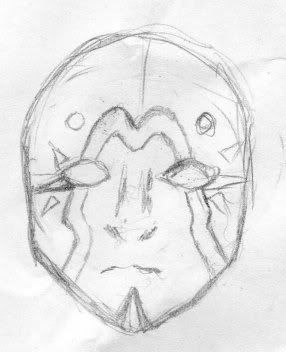
Sometimes, the paint dip on the forehead would be extended all the way down the nose, and in some cases 'teeth' are painted around the mouth, but this is the basic gist of most known examples of 'Paracas Sharkface'. Another version involves shark masks rather than face paint.
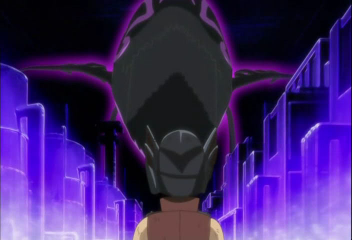
Making this the most hilariously appropriate if apparently uneven faceoff ever. That they used this as an 'early warning sign' that Crow would become a Signer makes it an even more hilarious 'jaws of the whale'.
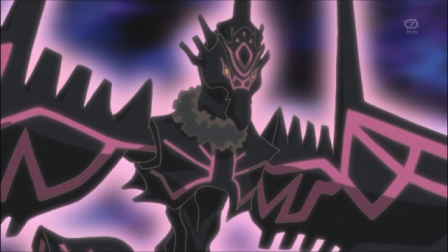
Wiraquchasca, or 'Wiracocha Rasca' is the Earthbound God that had me almost literally shitting bricks over mythology failure until I realized it should probably actually be 'Wiracocha Huasca'--'Rasca' was an early mistranslation of this second word. 'Wiracocha' can refer to the creator Wiraqutra specifically (incidentally, an incredibly benevolent deity related to Kon, mentioned earlier), but also directly means any truly powerful god (also, a white man or very pale person; paleness was supposed to indicate the touch or favor of the gods and the gods typically appeared as pale and light-eyed people). As for Huasca, this is literally a rope or chain; any kind of powerful or restrictive binding. It's also, like Ccapac Apu and Ccarahua, the name of Incan royalty. In the case of Huasca, he was one of two brothers who became emperor after his father's death--but he desecrated the temples and treated the people cruelly. Shortly before the conquistadors showed up, his brother--who was ruling the other half of the empire--attempted to reason with him for a way to end the conflict and uprisings, but Huasca instead sent a crew out to his brother's place telling them to kill him and his priests and generals. Unfortunately for Huasca he was a manipulative dick who no one particularly liked, and the entourage he had sent to kill his brother instead turned on him and he was captured. His brother secretly ordered him to be executed, instead of brought home, before the Spaniards could realize what a delicate and chaotic state the empire was in. More on the imperial bro-bros later.
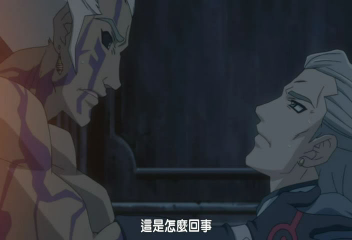
I haven't seen the episodes. But Possible Relevance is Possibly Relevant.
The Condor, as a bird, was associated with death. While the Inca tied it to heaven, because it dutifully led the dead to their next station in life, it just as often took sidetrips to the gates of hell. The condor also was the guardian of the mythological founder of the inca; later, not wanting to surrender his wise companion, the great king sealed the bird and trapped it in a box to be consulted as an oracle. Condors see many things, and even the gods consult them--so much that in exchange for their wisdom, they are given permission to eat the dead, even though the dead were considered sacred and inviolate. Those who kill a condor are believed to suffer an incredibly gruesome and unpleasant death themselves and then suffer further in the afterlife. The condor, prone to being disgusted by the antics of lesser beings, has been known to take the curious living to visit heaven or hell...and then either leave them there to the mercy of their guardians, or let them fly back to earth the fast, scary, incredibly-hard-stop-at-the-end way.
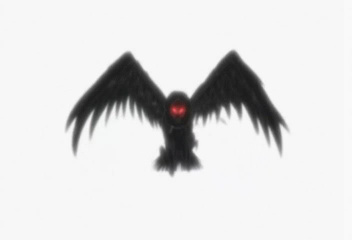
So basically, they're enormous asshole know-it-alls who will totally fuck you over. Like Rex. What a pair.
Black Feather Ankaa was obviously meant to mean 'anchor', but ankaa also coincidentally happens to be a quechua word meaning a small bird of prey, such as a sparrowhawk or falcon, which sharks transform into when they move from sea to sky. Highly associated to Paracas shark-shamans. Lawl, Crow.
Little Odds and Ends
Gross social stratification isn't just a current events gripe. A notable piece of pottery Moche pottery shows a scene in which many warrior-priests--the elite class of their society, those chosen by the gods--and their homes stand on top of a platform made of lesser spirits, which his held up on the backs of the laboring lower class. At one end of the platform, the warriors hand down their broken weapons and tools, which are passed along the lower class who are shown to labor over them, and at the other end the repaired tools are handed back up.

Historically, the Moche state was a highly stratified society in which the elite warrior-priest caste was supported by the laboring class, and their cities based around major urban cores surrounded by residential areas to support them. Rather like so:

Their politics were based on non-violent persuasion and physical coercion with an emphasis on the use of ideology to control and manipulate their subsidiaries and the masses. They had two main city-sites--one a religious center, and one populated largely by the labor class.
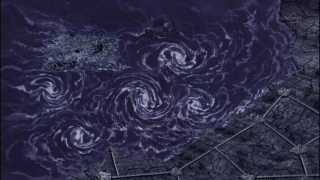
Cut me some slack, it was the only shot of Satellite + City I knew of.
The Star Guardian, sadly, does not really get elaborated on beyond a name. If pressed to come up with the signifigance of it though...Well. Stars had a lot of significance to the ancient tribes. Incas for example believed (or at least told people in the empire) that every tribe had come from a different constellation. In this way, the Incan king was not only the 'sun king', but also the 'star king' because he ruled over all the people of the stars. Kings, and the lines of kings, were almost always tied to some star or the sun, in which case one could argue that the 'Star Guardian' was supposed to watch over the line of kings. The Milky Way was considered the river of heaven, and during elliptic cycles when the rising sun appeared to touch it the gods would come down that river and walk the earth. 'Day' gods who were not required to pass through the underworld (like Chuqichinchay, the red star dragon/jaguar) lived in stars during the night until the sun returned to the world above. The Ayamara and Uru believed that all of the wisdom of the world came from stars. Both Moche and Nazca refer to a great and wise 'people of the moon' who lived in the mountains and came before them (possibly the Chavin). Most likely, though, I would probably say that the 'Star Guardian' role had to do with the line of prophets and priests. It was believed that the stars themselves wrote time, and that by observing the stars one could see the future waiting behind you (because we walk backwards into the future, which is why we cannot see it). The 'path of stars' is the path into the future, on which one can finally turn and see where he is walking; this actually shows up in the duel between Yuusei and Jack when they see Satellite's destruction. But because it takes the Earth approximately 26,000 years to complete a single precessional wobble on its axis, it takes a long time to notice the change in the day on which a given star or constellation will rise--a long time to do star-reading with just the naked eye to help you. So the rate of recession observed in this manner is approximately one day every 72 years. This meant that one single person could not do it alone. The task, and recorded observations, were then passed on to the next generation to be continued. It was for this purpose that myths were written; over the course of a 72 year precession, a pattern would be seen, noted, and integrated. This of course was considered a very important role in ancient Peruvian societies because it allowed them to prepare for the future. Their entire religion and culture was literally dictated by the writings of these star-watchers; they are the true shapers of the Incan Empire and those that came before them. It was the words of these star-watchers that led the Chavin to leave the mountains and their words that divided the tribe. They saw in the stars that the weather was the displeasure of the gods, thus leading the Moche and Nazca to enter the war that would destroy both tribes, and they predicted that the Incan Empire, when it formed, would end when the sun and 'Mayu', the river of the milky way, ceased to touch.
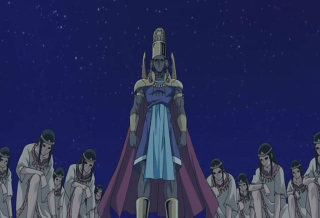
It's interesting to note that the Incan civilization actually did begin with the period of the sun touching the milky way, and did in fact end with the Spanish invasion right around the time the earth's shift caused it to stop. One might argue there was something to all these predictions, or maybe it was just another self-fulfilling prophecy. Anyway, that's my two cents on the Star Guardians. Rex DOES mention that they (or does he say it was Iliaster?) have been dictating history for a while.
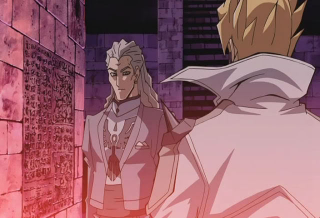
Corruption of the People of the Stars and sealing of the Wicked Ones appears to have been a complaint of the Nazca people, actually, who were avid star and nature worshippers. Like the people of the stars, who Rex claims were being corrupted and falling into decline due to contact with the wicked ones, the Nazca culture began to decay as they made war with other tribes. . .largely, it seems, the Moche or their post-Whale-sacrifice offshoot the Wari, who were rising in power by their associations with larger tribes that would become the Incan Empire even as the Nazca collapsed in on themselves. The Nazca culture and religion never recovered from this. Oh, yeah. And the age of the Nazca lines corresponds with a period during which there were a completely unprecedented number of solar eclipses over the Nazca Pampas. 'Eye of God' phenomena and all that. This matches up nicely not only with south american 'impending solar age' imagery, but also with YGO-dom's consistent use of the vanishing of the sun/death's halo/black sun as a sign of the Ultimate Final Battle Between Evil And Good Or At Least Slightly Less Immediately Destructive. So the creation of the Nazca lines matches up perfectly with a period in which such an 'ultimate battle' as Rex describes resulting in the sealing of the Earthbound Gods would be expected to be taking place. By the way, is it noteworthy that Moche temples, particularly to their decapitator pantheon, were mostly underground? It was even common practice for them to seal their greatest rulers and warriors in the earth. Their sun-temples, while huge, were largely underground: doors to the 'black sun' of the underworld.
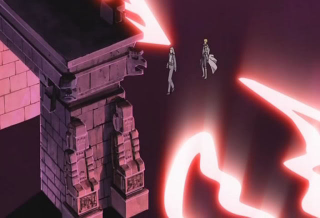
Much like Rex's Magical Cultist Basement or the DS hideout in the Old Momentum crater.
Rudger and Rex are excellent immediate examples of how a Signer or their mark can be corrupted. Rudger also talks (often through his spider-raped proxies) of corrupting Signers and darkening their marks early in the story arc.
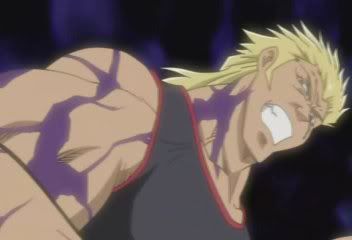
Killer Rainbow Energy features strongly in the Moche culture; they even have a temple dedicated to it! One of the snakes frequently seen with Aiapaec is a 'rainbow' serpent with one black head and one white head, one head rooted in heaven and one in hell, representing the great god's joining of the energies of all three worlds. To the moche, the rainbow is a symbol of a never-ending cycle of new life and fertility passing through the worlds. Either head however could pull free (or be pulled free either by Aiapaec in the earth or the serpent in the sky) and bite; obviously with all this energy such events were believed to be rather catastrophic. Particularly destructive storms were sometimes seen as a result of this if a rainbow was visible in the sky afterwards; it was proof that the God In The Mountain had beaten the damn thing back into submission and all was hunky-dory again. During certain periods it was believed that if not for Aiapaec's control of the creature, it would bite through the world and the sky.
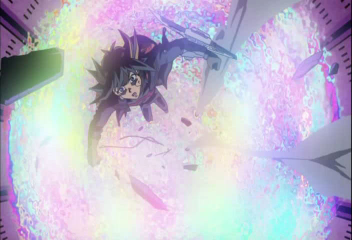
Now THAT'S what I call 'momentum'.
The Gate of Birds, also known as the Gate of Fish and Birds, is actually most prominent at the Chavin site, but also appears in some early moche/nazca locations. It's pretty much exactly what it says on the tin: a 'gate' or arch, sometimes a long passage, covered with images of birds, often in the process of becoming fish (or fish becoming birds). Passing through the Gate of Birds supposedly allowed one to pass, for a time, into the realm of the dead without oneself dying. Because the wisdom of the dead was so highly valued, this baby got a lot of use.
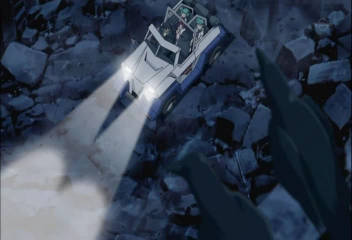
The sequence wherein we drive past rows and rows of blackbirds on our way to go chill with the dead cultists is, therefore, pretty fucking hilarious.
Death and the illusion of life is something we see from the Dark Signers; Kiryu's eyes get their whites back a few times, but much more notable are Carlie's regression to a 'living' state after her duel with Divine and of course Misty prancing around doing her supermodel...thing. I have a running theory on this that the state of being convincingly 'alive' is linked to the presence of the Earthbound gods in them. If living man is made from the blood of a god (as is widely believed South American cultside; it's why so many of their gods spent half of their time above ground and half of it below in hell, unless of course they were locked in the latter as the EBG seem to have been), why shouldn't the proverbial heartbeat of one inside of them return them at least to the illusion of life? If pressed to explain, I would say that these 'wicked gods' are coming for the mortals who have their lifeblood. All the gods were bleed out for this creation schtick, after all, and might explain the 'destined to fight' thing a bit from the DS side of things. Blackeye Zombie Syndrome may be tied to the more typical ritual state, where the god moving through man is purely ritual and transitory, but I tend to think of the Dark Signers are slightly more literal 'walking temples' than the Nazca glyphs (which it is generally believed were 'walking temples', yes; that is, temples in which the ritual was carried out why traveling the lines, much like the 'sacred roads' leading down from the mountain sites). So at rest, when the gods 'sleep in the temple', a Dark Signer might be totally indistinguishable from a normal person because the blood of god is being held in them despite the fact that they should be dead, and that's what gives life, whereas when the god is awake in them, they have reclaimed that blood. I can see this making a good amount of sense for why Kiryu would be in an apparently almost constant state of 'blackeye', since the Traveler is NEVER at rest, and Demak and Rudger seem to spend a LOT of time chilling in the 'temple of the gate', thereby suggesting that they remain in a 'ritual' state more often.

Or I could just be talking out my ass again, as this of course is just wild speculation on my behalf and has EVEN LESS actual basis in what is stated by the show than usual.
Men with two gods, we has them! The only incidence of religious markings specifically on the arms, so far as I could tell, is in the case of emperor Atahual, or 'Ata Wallapa' ('the happy bird', ffff, what a name), Huasca's brother. When the conquistadors first showed up, he was uncertain if these pale men where really wiracocha (gods, or touched by them) or quitas pumarangra (wandering murderers and deceivers). So to be safe he carved a sign in each of his arms--one for the gods of day, who were friends of the Inca, and one for the gods of night who sleep in hell--and asked them to tell him what to do. The sign for the day gods healed quickly, but the mark of their hellbound brethren remained, and in fact scarred him, leading him to tell the Conquistadors to go fuck themselves. This ended poorly for the Inca and Atahual himself.
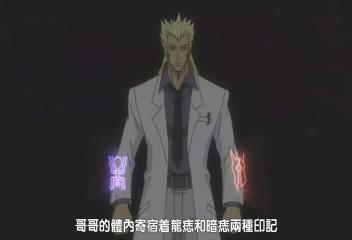
It ended poorly indeed.
The placement of Rex's marks are also interesting to me, and mildly amusing in the face of comments that the placement of them regards to 'the dragon on his chest is his hope for the future!!!' I've seeing in the fandom. The back and chest are much more typical locations for religious markings its true, but in Peru, and especially among speakers of Quechuan,'the future' is considered to be behind us (because we can't see it), and the it's the past that's in front of us (we can see it clearly). Typically, if one hopes for a god's favor or protection in the future or future endeavors, one places their mark on one's back. To have a birthmark on one's back indicates the future fate one is destined to. In case there was ever any question Rex was doomed. You know. The placement of the condor on his chest earlier in the series may have represented his hope to put the endless conflict of the gods in the past, however. That may be the reason for the placement on the chest of the dragon, too.
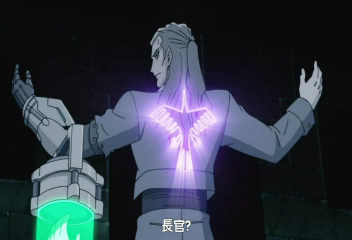
Hellgod and the Star Dragon is not a rock band, but another feature we see cribbed from the Nazca and Moche rather than the later Inca. The moche's 'head' decapitator (Aiapaec or Chalchalcha, depending on whether he used his 'jaguar warlord' or 'winged demon' form), the god in the mountain, was considered to be at war with a great serpent in the stars above, who was his mortal enemy (in some stories it's his brother, in others it's his father). Notable perhaps is the fact that Chalchalcha/Aiapaec was known to be attended by--among other things such as bird-faced serpents, a pair of shrine-lizards, and a warhound--many 'little crows', black birds, who flew in and out of hell as his warriors and messengers--we see similar birds in ep 63 coming from yon sludgy.
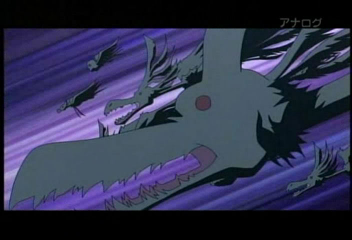
Among the Nazca, we then conversely have this rather unique sky-dragon associated with images of the eclipse, which is the 'eye of God':
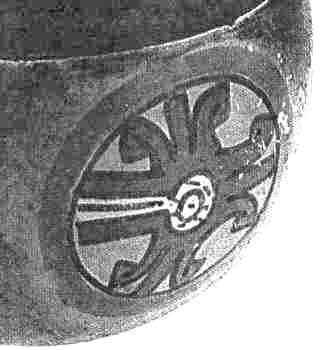
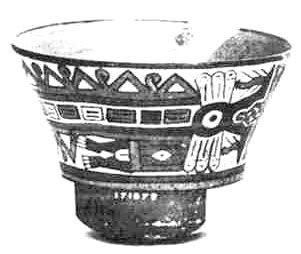
This bright red dragon--with a head at each end, like most peruvian dragons despite its slender build--had bold, rayed yellow marks around its eyes. This 'eclipse dragon' also appears on the 'brow of the heavens' figurine, where it arches over the eyes/stars in an eclipsoid shape itself, which gives the symbol it's bizarrely alchemic look. Because it also appears prominently as a feline figure in earlier art, and sometimes with feline features, some archaeologists believe it to be an early form of Chuquichinchay (the jaguar spirit living in the red star) who is, like Aiapaec himself, a later form of the Chavin snake-jaguar god--just the version the Nazca took away; a less scary, rip-your-head-off-and-drink-your-blood incarnation than either of them. He later became regarded as a simple guardian of animals. I'm really not sure how that happened. But it suggests this whole fight is just more blasted brother issues.
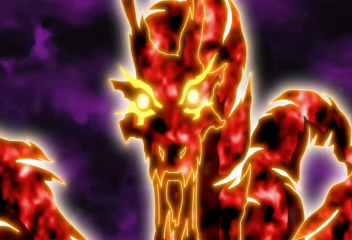
Speaking of Aiapaec, in the unholy darks of one of my books, I found a brief passage, one lonely mention in all of my wanderings, of everyone's favorite hellbound decapitator Aiapaec/Chalchalcha appearing in a purely human form, rather than his typical crazy man-jaguar-snake-spider-ohgodwut mode. And the description of this human is of a small warrior with scarred and painted face, 'wildly rayed' red hair 'emergent from over a blue headdress', and some gonky dangle earrings. If he doesn't sound familiar yet, remember that Aiapaec is constantly attended by little black birds who act as his messengers in and out of hell, and that he is fond of giant, toothy grins and excessive spectacle. What. The. Fuck.
POSSIBLY RELEVANT! Aiapaec has at one point actually fought and subsequently kicked the ass of the death god/god of hell, Supay, who he had previously been relatively neighborly with. Why? Because said hellgod was being creepy and threatening at the children of his people, which he saw as his own children. Apparently, no one except baby-eating whalegods is allowed to fuck with Aiapaec's kids.
I freely admit this one is mostly here for lulz.
And speaking of The Crimson Dragon, Peruvian dragons--far different than their counterparts further north, in Mexico and Columbia--are only very rarely serpentine, and they are certainly almost never portrayed as circling back on themselves. They are however almost exclusively two-headed, with the tail being a second 'face', and one looks forward and the other looks back behind it, indicating that they know both the past and future and making their use as 'guardian' symbols rather reasonable. This dragon however is particularly interesting because it's drawn in an 'oroboral state': that it, it appears to be ready to eat its own tail. In addition to meaning that the face which usually looks towards the past looks towards the future and vice-versa, this of course is an alchemic image representing cosmic, or heavenly, energy. The Oroborus (or Oruborus) is a powerful and well-known symbol of the very deepest principles of alchemy. Both immortal and existing in a constant death, both self destructive and self sustaining, it is a mercurial entity often cast in gold and representing the principles of 'like begets like' and 'all things for a price' in their purest and most literal form. A red oroboral sign, like a gold one, is indicative of a pure and divine power; not of a 'constant life, constant death' state but rather a state which has transcended both living and dying, which can neither be destroyed nor requires to be sustained. A 'heavenly' energy indeed. If the dragon IS gunning for 'lawl, Alchemy' as a symbol, those yellow bands on the critter itself do raise some eyebrows, but this is more likely a ref to the Nazca 'eclipse serpent'. Interestingly, the peruvian eclipse and oroborus are similar in principles.
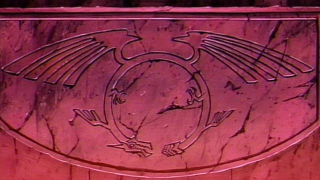
Honestly, it was hard to decide if this entire passage went in the 'Peru' post or the 'Alchemy' post. BAH.
When the dragon moves to Inflatable!Rex's abs, we get another twofer--though on glance it resembles the alchemic symbol for the sun, the 'incomplete oruboral arc', in which the dragon's head and tail are not actually joined yet leaves a gap more like the image used in GX to represent the 'sign of Amnael', who was the otherworldly being responsible for returning the secrets of the third world (alchemy) to mankind and the gods of men after they had been taken away for their misuse. Since no one knows what the actual mark of Amnael looks like, it might be noteworthy that the design used by these crews is identical to the outline of a Chavin prayer circle seen from above (the broken ring, with a deliberate 'ritual point' in the center), wherein we get our twofer--the Chavin people were the ancestors of both the Moche/Wari and the Nazca/Paracas. It was their 'god of the old mountain' who eventually became the great Moche decapitator and the Nazca eclipse serpent both.
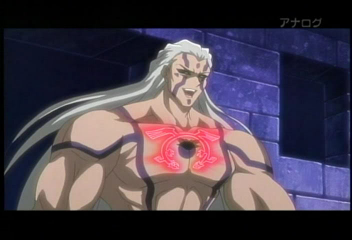
Inti and Quilla, the Incan Sun God and Moon Goddess, make cameos as two of Rex's cards. They're married, it's sweet. Apocatequil the thunder god and our old buddy Supay also make card cameos in the game. Someone seems to have told TV Tropes that Manco Ccapac, son of Inti and Quilla, is Apu Ccapac, but I'm fairly confident this is incorrect.
The below will later be edited/integrated into the main body of the post. If I replace it with new new content it will be then, otherwise I'll probably get around to it when I make the next metafag post.

If this cringe-inducing grade is familiar, you may be familiar with south american temple-and-palace architecture. Their important buildings were designed as close to completely verticle as plausible to humble the 'mere mortals' who climbed and/or were dragged up their steps. We're totally unsurprised Jack's pad was on top of something so pretentious. And hey look! Remember what I said about the palaces of the Moche kings and prists being held up by lesser spirits? Dig those gargoyle/demon carvings on the pillars, man. Subtle!
Regarding Uru, Rudger, and Momentum: It may be noteworthy that as the favored form of the decapitator cult's head god Aiapaec, it is often the spider who is depicted as grasping and controlling the infinite energy of the rainbow serpent--but also that in the earliest versions of these myths, before the Moche properly became the Moche, the same rainbow serpent had been controlled by the 'father figure' who was the serpent in the sky. According to one story, when this power shift occured the serpents DID in fact bite all the way through the earth and sky, ending the age of the sky god and prompting Aiapaec to create his own people, the Moche. While admittedly the star-serpent in 5Ds generally seems to correspond to the Crimson Dragon, the changing of hands of the Super Killer Rainbow Power from a father to a giant fuckoff spider and ending the world in the process does seem to be a theme they kept with.
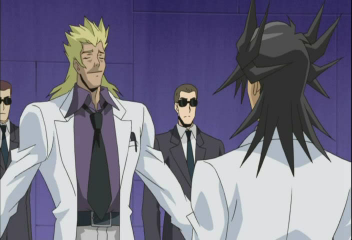
I'm not sure if this should get filed under 'Uru' or 'Killer Rainbow Energy', to be honest.
Damn does this screenshot make me smile.
Adorable Rape Spiders are slightly more prominent in Mayan mythology, but down in Peru they also have their place. These tiny little ladies--whose preposterously long name escapes me at the moment but essentially means 'little sisters beyond counting'--supposedly attack the sun during eclipses, trying to weaken it and take its blood so it will have to stay in hell. At the end of the world, or when the sun is very weak and therefore requires sacrifces, it is believed that they may also walk the world. Early in the process they will appear as tiny spiders with skulls on their back.
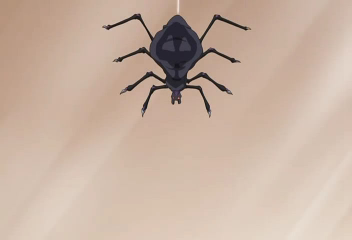
I hope the 'little sisters' or 'extended family' jokes I make about Rudger sometimes are starting to make a bit more sense.
If the sun proves too great an opponent though, these precious little cuties can also climb into the skulls of mortal men and use them as sacrifices in rituals dedicated to the night gods in hell and strengthen themselves...and their already considerable numbers. If they did well and succeeded in these rites, it was thought that the gods of hell would make them grow into women with four arms and four legs and beautiful bodies but, you know, bloody spider-mandibled skulls for heads. They would wear ponchos/wraps to hide their extra limbs in and cover their heads and faces to lure/seduce men close enough for them to drink the blood of the gods from them, replacing it with more little sisters. These men were then controlled by the millions of tiny little spiders scurrying through their veins, and they too would turn on each other and the sun. If they weren't killed quickly and in the properly ritual manner, it was believed that eventually the Little Sisters would burst out of the possessed body to join their siblings in the battle against the sun. When the ladies start doing all this, by the way, it is supposed to be a sign of the end of the world coming. A really CREEPY sign.
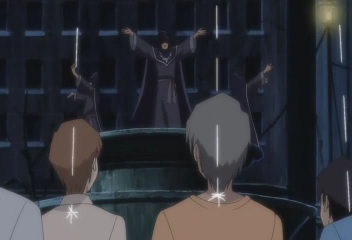
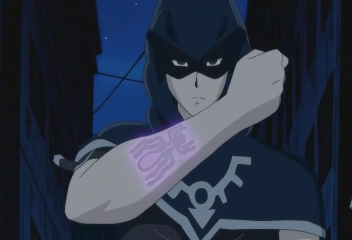
I hope you didn't need to sleep tonight.
Dragons
I was so busy putting up the Moche Decapitator Cult Earthbound Gods with their delightfully relevant and blatantly obvious names that I forgot all about the slightly better disguised Nazca pantheon cameos. Terrible.
So let's start with the bird-god. I know there are speculations on which Incan or Mayan deity Stardust Dragon may be associated to, but for now let's match Nazca for Moche, Martyr for Murderer--oh wait, that's next time. Oops. Anyway, the Nazca sky deities had a lot of significance--remember that the walking temples could be sustained only as long as the weather on the pampas remained perfectly unchanged--and mixing bird imagery with not only dragons but also stars suggests they were going for another reference to the sky-father/eclipse serpent here. Not very subtle. Specifically, because so many South American cultures believed that the dead remained with us to guide and lead us, and that a tribe's dead warriors and priests were just as dangerous as their living ones, the combination of dragon--a guardian and watchful force--and bird--who moves between life and death--suggests that the bird-dragon guarded the living against the dead. This mixture of protective symbols was especially prominent in the early period of the Moche's war against the Nazca, and had a resurgence around the time the Moche appear to have broken open the tombs of some of their earlier warrior-kings for extra supernatural buttkicking power.
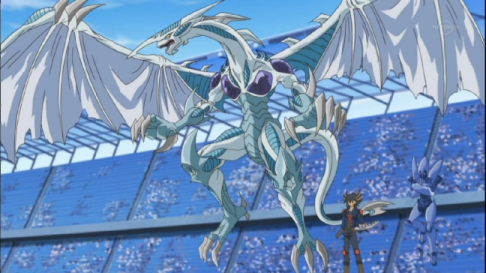
Stardust, he of the giant beak-nose, also moves freely between life and death, since his effect allows him to revive provided he martyrs himself. So yeah.
The Horned Beast was the Nazca war god--don't think that just because they were a bunch of nature-worshipping agricultural hippies that they didn't have one. This god of kings and warrior priests (the only ones allowed to use depictions of him) was pretty much exactly what it says on the tin, really...interestingly, he's a major member of the Nazca pantheon who ALSO features prominently in the Moche decapitator cult, possibly because he seems to have developed by smooshing together a couple of other, older gods (including my personal favorite, the Chavin god of supplications) from their mutual forebearers. It's suggested in our limited Nazca images of this guy that those who were able but did not stand up to fight for the tribe were struck down by this guy's claws and dripping, blazing breath. These guys were not fucking around when it came to defense of hearth and home I guess. He does appear on the Nazca pampas, actually--his is the stupidly large glyph only recently discovered via satellite awesomery.
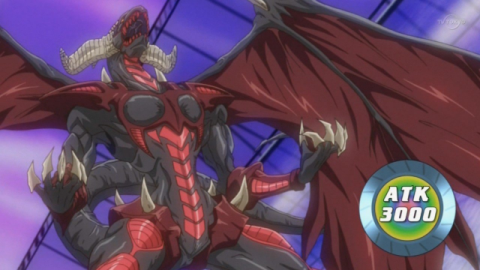
Incidentally, he looks a HELL of a lot like this.
If I find a really good picture of him that's Nazca instead of Moche--which most of the ones you see are--I'll post it for comparison/lulz.
The 'earth mother' figure, in Peru, is often depicted as a dragon--and the Nazca are no exception. The earth dragon has the typical two heads, but she also has the interesting habit of being split into two dragons--a benevolent guardian and grower of new life, and a raging earth-rending she-beast. The Incan Quechua would later name these two 'Pachamama' and 'Pachatira'. One end of this split dragon-mother--with arms but no legs and a smooth or maned neck--was one of the gods most strongly affected by the post-war Moche influences on Nazca religion and culture. Once satisfied with agricultural or symbolic sacrifices, this benevolent nature-goddes began demanding severed heads.
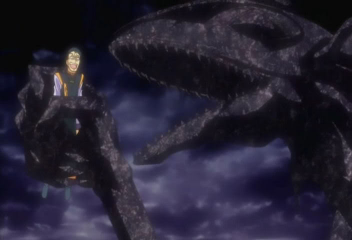
Preferably of creepy child psychologists, it seems.
At this point, her 'earth goddess angry, earth goddess smash' half--typically depicted with legs but no arms and a neck covered in spikes--seems to have gone largely defunct. In some cases this seems to be because the two have been rejoined; in others, the second half seems to have simply dissappeared. When she finally reappears as her own entity again, in Incan myth, she is belieeved to have taken up residence in one of the fascinating 'black cloud constellations' so prevalent in the Peruvian sky. Seems like a weird place for a disenfranchised earth goddess.
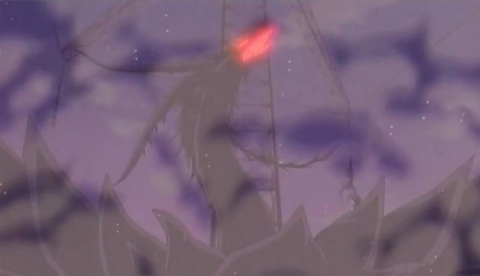
But then again, maybe that's why she's so pissed.
There will be more on the intristic connection between Faerie and Rose in the alchemy section. Don't think there won't.
Bird-faced serpents don't actually show up in the Nazca pantheon at all, nor do they appear in their art at all until the war with the Moche, at which point the God in the Mountain Aiapaec's propensity for wearing them like the latest hot accessory was forcibly introduced along with the rest of the Moche's charmingly violent culture. Now, the Moche regarded these bird-headed serpents as (in addition to the ultimate fashion statement) their 'head' god's bridges and messengers into the deeps of the earth--much like the black birds were his messengers into the seas and skies--as well as prophets and the secret-keepers of unknown places, not to mention guardians of the 'lower realms', which meant to them not only the underworld but also the lower labor class and their seperate little city. To the NAZCA however, these creepy crawlies quickly became a symbol of their own cultural decline and corruption at the hands of the Moche. As such they can often be seen wrapping around Nazca deities in later-period pots and textiles and dragging them down into the underworld, sometimes drinking so deeply of their blood that it burst out of their skin and eyes.
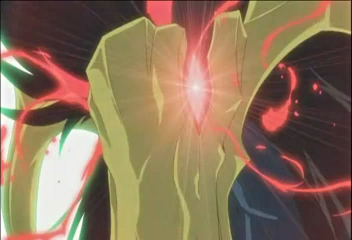
I think he's got a little something on his face there. These kids are such sloppy eaters.
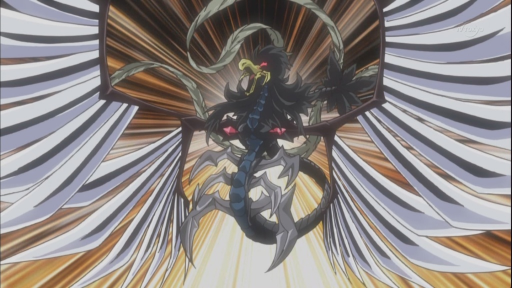
All of this, honestly, kind of makes this the odd dragon out from a referential standpoint. Why are all the other dragons clearly Nazca deities, while Crow gets yet another Aiapaec reference?
Is it noteworthy that among the depicted victims of the Moche's bird-faced snakes are not only the once-benevolent earth goddess, but also the god in charge of tools and temple building, who utterly vanished after that point except to appear much later, among other cultures, as a lesser 'ancestor spirit' type? Is it?
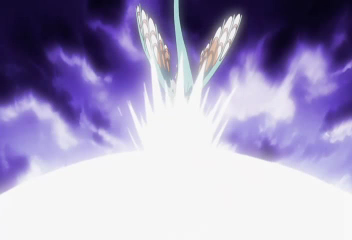
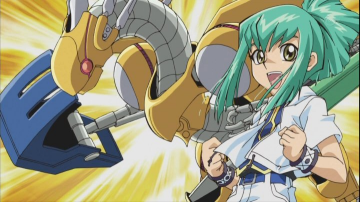
Nah. Couldn't be.
at least it would explain what the fuck happened to change the fifth dragon into BFD
There WILL BE another extensive section on the five/six dragons in the Alchemy and Arcadium section if I can find a way to coherently express the awesomeness that is their simultaneous representation of the ascendant process. I am still trying to figure out exactly which rungs on the ladder some of them sit on because Rosie's lack of claws throws me when paired with...er...nevermind. I'll get to it.
On a NON-GEEKY NOTE, I have to wonder if the relations between Japan and Peru might not be a cause for the prominence of Peruvian mythology in both 5Ds and also GX. Diplomatic relations and emigration between the two countries opened up in the late 1800s, after all; thousands of millions of dollars in imports and exports go between the two; their prominent minsters and politicians visit each other, they give each other cultural grants, they even have a holiday celebrating the friendship and union of their two countries. Japanese Peruvians--that is, people of japanese ancestry who either emigrated to or were born in Peru, known as 'nikkei Perujin', make up about 3% of the population of Peru as of 2008, coming in at over 90,000 strong and making up the second largest ethnic asian group in south and latin america.
The trouble comes in with the Dekasegi--the 'working away from home'. In the 1980s and 1990s, Japan suffered a major labor shortage and began a program to bring ethnic Japanese living in Peru and Brazil back to the country to work in industrial jobs. When the finanancial crisis we all know and love cropped up however, many more Nikkei Perujin, and also Brazillian Japanese, fled back to Japan to escape the complete and total economic collapse occuring in South America. They then took advantage of Japanese citizenship and immigration laws to scrape out a niche similar to that of those who had come in the earlier 'Dekasegi work program', even as the Japanese goverment was scrambing to get THOSE workers to go back and clear up jobs. Unfortunately, this has pissed off a large number of non-nikkei Japanese, who look at them as foreigners and not having a right to take their jobs and space (which the nikkei workers in turn resent right back, as they still view themselves as Japanese). The tensions over this issue have actually made international news a few times they've risen so high--in fact, at around the mid-point of 5Ds extensive first season, when the Peruvian cults really reared their heads, I believe I recall hearing a radio broadcast that suggested hostilities had nearly broken out in the streets and that one or two of the ethnic neighborhoods inhabited by these Peruvian Japanese laborers were actually being targeted by drive-by harassment and vandalism seemingly aimed at running them off. Currently the Japanese governement is actually offering Nikkei migrants a hefty cash sum if they'll go the heck back to their country of origin, but this has only seemed to increase the resentment of all involved.
Again, I could have some major facts wrong here--I don't get a LOT of exposure to Japanese media, I just know what's spilled over onto english-language radio and news broadcasts. I'm just saying, all these Peruvian badguys hanging around the ruined industrial sector--after Japan gets fucked by a guy involved with Peru... It seems like someone might be making a statement on current events.
I may have missed something/a lot. In any case, that's it for this session! I'll be away for a week, plus I have two jobs, art commisions, and a major ongoing translation project on my plate, so don't expect the next one any time too soon.
NEXT TIME: Do As I Tell You vs Do As Thou Wilt--Iliaster, Arcadia, and Alchemy, oh my!
There will actually be several of these, with different posts covering different kinds of nerdery. For those who wonder, the only reason this is going up before the GX stuff is that I already had these ones partially written up, from a forum. However, this version is largely exanded. And will continue to expand as I find more crap that I made notes about but promptly forgot upon losing interest in the show.
Also bear in mind that I am by no means a 5Ds expert! I have not watched all of the first season (I consider this the series start through the end of the Dark Signer arc), and seen about...four episodes of the current season, two of which are this week and last week and one of which was the totally random filler 'driving class' episode. So if I have a series fact grossly wrong, or have missed something that should be glaring obvious, please tell me! Also feel free to ask about anything. This will also not be all-inclusive. For example, I know Divine calls Aki his 'Jeanne d'Arc', and I know there's a Daedalus/Icarus thing going on, but I'm going to assume everyone catches those. They're not exactly obscure.
Oh yeah, and this has spoilers. Lots and lots of spoilers. Also PICSPAM.
Section 1:
First things first--Vocabulary!

Signer (rough pronunciation 'sigu-na' in the show) vs the Quechua 'Siq'u nana' (rough pronunciation siKu-nana; very hard k with a glottal 'g' roll, very similar sound), which would be 'Driven By the Mark'. Y/N?

'Ccapac Apu' means, loosely, 'virtuous king', and he is in fact named after Apu Ccapac, an Incan emperor who greatly united the tribes of Peru early on. This also however refers to the line of 'pure inca' descended from him, who ruled along with their closest family and inner circle. Anyone who was not a member of this group, or attempted to root ideals or methodology in the incan society contrary to this, was either exiled or brutally killed. Dissatisfied with the way other quarters of the empire were running, they moved systematically through the areas of the empire, killing off the ruling families in them and taking their place while miraculously seeming to take no casualties themselves along the way. However, these restless Ccapac eventually spread themselves too thin, and were destroyed by dissention and miscommunication within their own ranks.

Why yes, I do believe we've heard this story before.
In 5Ds, the monster Ccapac Apu is of course the glyph of the 'man'. While many new-age morons call this the 'astronaut', tribal people of Peru call it either the 'giant' (as he is dubbed in 5Ds) or 'traveller'. In the creation myth of Wiraqutra, the first life he created on earth were great stone giants without eyes or mouths, who wandered aimlessly over the lands. Because they displeased him, he destroyed them and started again. 'The Giant' (I prefer 'traveller', myself) is also one of the glyphs the Nazca people had in common with their delightful neighbors, the Moche and their decapitator cult. In both cases he is seen as a warrior and leader; in both cases he is also one of the guardians of the gate into the underworld (in which role he's also a bit of a showman and artist). It is believed that he calls up the damned from hell into the eyes of the images and statues all about him.

Well we definitely don't have anything like that, so let's move on.
I have heard that something about Kiryu as a 'death god' comes up in Crash Town. Not having actually watched the arc I don't know, but yes, this would make that not an entirely innacurate statement.

Aslla Piscu has the most delightful name ever. Though Quechua has a perfectly good word for 'hummingbird' (qu'enti or kinti, if you're wondering), this means 'little crow'. However, it can also be translated as 'little penis', leading to some SERIOUSLY. EPIC. LULZ. This one is not named for incan royalty, but rather a meddlesome spirit who tampers with human hearts and relationships--further evidence of the theory that Penis Ruins Everything.

That's a big ol' "check".
Among the Moche, the hummingbird was one of their war gods, responsible for bringing back prisoners to be sacrificed on the altars. Among the Nazca and Inca, hummingbirds were considered 'sun creatures'. Like all small birds in Peruvian mythos, they were believed able to revitalize and ressurect themselves at will, moving freely between life and death. Their dead bodies were carried to help one find success in love. However, a live hummingbird in your doorway is a bad omen, which means that a distant loved one has passed away (such as, say, by being chucked out a window). As for 'little crows', the 'head' god (lololol) of the Moche decapitator cult was attended by small black birds who flew in and out of his mountain lair as his messengers; these were his links between heaven and earth. Interestingly, fish and birds were considered to be largely the same creatures, as the sea and sky were joined. Which is why, should you ever use that ridiculous 'a fish might love a bird, but where would they live?' comment while vacationing in Peru, you would probably receive an odd look.

Ccaryhua is quechua for 'iguana'. Of the two lizard glyphs on the Nazca pampas, they actually use the smaller, more slender lizard--the gecko or anole--rather than the big clunky 'iguana'. Though this spelling is the least common, it IS closest to that of Ccarahua, a member of the incan royal family. Very little is known about her; she is said to have died shortly after her younger brother and otherwise did little of historical note.

Check.
In most peruvian mythology, including that of the Nazca and Moche, the lizard is not party to any particular godhood; instead, they take on the role of 'divine shrine attendants', always in twin pairs. The iguana specifically, however, accompanies the god of burial, and were themselves sometimes charged with leading processions of the dead, or guiding the living to their dead loved ones. Some believed that the iguana would lead them, if followed, to the killer of a family member who died under mysterious circumstances.

Justice Lizard successfully strikes again!

Uru is Quechua for, quite simply, 'spider'. Among the Moche, this was one of the greatest gods of the subterranean decapitator cult as one of the favored forms of its 'head' god (I need to stop doing that); their very ritual practices, which involved binding and the long-term bleeding of a sacrificial victim over as many days or weeks as possible, rather than an immediate sacrifice, are inspired by the behavior of the spider. The spider's many arms were used not only to hold the ritual knives, but also to allow it to better manipulate the world around it. Even in more benevolent forms, as among the Inca, the spider is a manipulator--when Kon, the creator of the world in the previous cycle, went after the twin children of the 'creator' who had taken his place, the spider tricked him into climbing up the mountain to look for them, from whence he fell through a chasm into the spider's lair and died hideously. The twins were later made into the sun and the moon. Many believe the story of Kon and and his later, rival god is an allegory for the conflict between the coastal Moche/Wari--who became part of the Incan Empire--and the upland Nazca/Paracas--who did not. In this comparison, it should surprise no one that Kon is associated to the Nazca, and the moche keep their headhunter. Though seen as the 'villain' of this Incan story, earlier mythology cites Kon as a benevolent creator and a being of light who nurtured life and fertile growth in the valleys of Peru. Even when he took the rain away from the Nazca for turning on him, he still granted them rivers, that they might drink and not suffer. This both says something about the Incan bias and also spiders. Fucking spiders always kill the nice ones.
'Uru' is also Ayamara for 'dawn'. It is also the name of a tribe who speaks the ayamara language; this tribe believes that the gods, the kings, and all the secrets of civilization came from the stars. Their ancient kings, before they were conquered and absorbed by the Inca, spoke with a great god in the stars, who imparted to them the way the land would be ruled. The Uru live on man-made islands, and are one of the few tribes remaining active in the world today. So apparently their 'star kings' told them something right.
I actually skipped several (ie, most) of Rudger/Uru's episodes, so if many references to the actual mythology are made, I probably missed them. I do know however that Rudger's use of the little 'rape spiders' early in the cultist arc, as well as the throwing out of Rally into the first duel with Yusei, is in keeping with the spider's role as manipulator of the world at large. Also, that he tricked Bommer into coming back for some reason involving children then dropped him in a pit to his death. Fucking spiders.

Cusillu comes from the Quechuan 'k'usillu', which means both 'monkey', and 'fool'. I suppose it could be 'qusilu', which has a similar pronunciation and means 'clear-eyed man', or 'one who sees clearly'. Historically, this Earthbound God shares its name with a great warrior-shaman, whose fighting style lives on to this day and among the Ayamara has lent the word a third meaning (great warrior). Sadly, I know little of him beyond the fact that he apparently was really good at kicking ass. Despite the fact that its name is frequently used as an insult, the monkey in mythology was seen as shaman himself, sometimes a king, renowned for his cunning and cleverness. Though not appearing in the Moche decapitator pantheon, it shares a role with the Giant in their culture--the monkey guards the side of the gate between worlds opposite to his eyeball-fetishing artsy brother. If one wishes to speak with those trapped in the earth, one must go through this fuzzy shaman.

Such as dessicated dragon-fairies.
Yeah, I skipped these episodes too.

Chacu Challua, the baby-eating whalegod! One of my favorite of the moche decapitator crew. I've heard it suggested that this is from 'chuqi challwa', which is a kind of small fish in Peru (literally, 'little golden fish'). I have my doubts. For the whale god I suspect Ch'ak (blue sky) and chaku (hunting) are both equally more likely candidates for the first part; challa (sand) ch'allu (ripe) ch'alla (drinking) all compete for the second ('hunting drinking' would be indicative of great hunger and constant consumption, a trait of the represented god; 'blue sky sand' would cover the orca's perceived hunting grounds; ie, anywhere the fuck it wanted). Most likely of all however is simply Chaku Challwa, which would be 'hunting fish' or if you want to stretch it 'killer whale'. However you look at it, he seems to be the only EBG not to share its name with a historical or mythological figure.
So, this is another symbol shared between the moche decapitators and the Nazca. In addition to being a notable glyph on the pampas, the 'taloned whale' is a prominent member of the moche cult...and a huge part of why the tribe nearly died out. To both tribes, whales and sharks were considered the 'warrior priests' of heaven and hell; like the birds, they moved freely between worlds, but unlike the birds they were beings of obvious power and dealers of sacrifice themselves. Among one, they were considered to be protectors of children for their pod behavior, and represented by a larger and more benevolent whale glyph--and among the other, for their propensity of chasing baby seals onto beaches, chucking them into the air, and gorily chomping them down in seemingly pointed displays, they were considered eaters of the young. As such, when El Nino rolled around and started screwing with the coastal Moche, they went to war with their neighbors both along the coast and inland, taking their children to be sacrificed to the hunter-whale, who they hoped would speak well of them to the gods and bring good weather back. When this didn't work, they started sacrificing their own children, and nearly pleaded their way into extinction with the merciless orca. A Nazca textile displays this conflict between the tribes; in which an unusually huge and clawed Moche orca is seen stabbing a smaller Nazca whale, and laying waste to a veritable army of smaller fish and human warriors, with severed heads all over the place--possibly a rather bloody statement on how the conflict was running at the time. Possibly also a clue as to why the larger, less hostile whale glyph on the Nazca pampas is (or once was, I don't recall if they've been moved) strewn with whale bones.

Adorable Peruvian children: also known as 'Longpig Party Poppers'.
Frequently in opposition to the Moche/Chimu orca, we see the Paracas Shark Shaman. These shamans often faced deathly trials--or actively had themselves ritually killed--in rites known as 'entering the jaws of the whale'. In this way, they were thought to attain a power so great that human bodies could not hold them, and become sharks; shamans in attendance to the gods themselves (predictably, these sharks are interchangeable with hunting birds, sometimes portrayed as transforming as they go from air to water or water to air). As an amusing note, in 5Ds, we do also see the ceremonial facepaint of a Paracas shaman entering the jaws of the whale--Crow's criminal marks, taken as a whole, are strikingly similar, if not nearly identical: I've taken the liberty of (very roughly) sketching an example compiled from different angles seen on different pots and textiles:

Sometimes, the paint dip on the forehead would be extended all the way down the nose, and in some cases 'teeth' are painted around the mouth, but this is the basic gist of most known examples of 'Paracas Sharkface'. Another version involves shark masks rather than face paint.

Making this the most hilariously appropriate if apparently uneven faceoff ever. That they used this as an 'early warning sign' that Crow would become a Signer makes it an even more hilarious 'jaws of the whale'.

Wiraquchasca, or 'Wiracocha Rasca' is the Earthbound God that had me almost literally shitting bricks over mythology failure until I realized it should probably actually be 'Wiracocha Huasca'--'Rasca' was an early mistranslation of this second word. 'Wiracocha' can refer to the creator Wiraqutra specifically (incidentally, an incredibly benevolent deity related to Kon, mentioned earlier), but also directly means any truly powerful god (also, a white man or very pale person; paleness was supposed to indicate the touch or favor of the gods and the gods typically appeared as pale and light-eyed people). As for Huasca, this is literally a rope or chain; any kind of powerful or restrictive binding. It's also, like Ccapac Apu and Ccarahua, the name of Incan royalty. In the case of Huasca, he was one of two brothers who became emperor after his father's death--but he desecrated the temples and treated the people cruelly. Shortly before the conquistadors showed up, his brother--who was ruling the other half of the empire--attempted to reason with him for a way to end the conflict and uprisings, but Huasca instead sent a crew out to his brother's place telling them to kill him and his priests and generals. Unfortunately for Huasca he was a manipulative dick who no one particularly liked, and the entourage he had sent to kill his brother instead turned on him and he was captured. His brother secretly ordered him to be executed, instead of brought home, before the Spaniards could realize what a delicate and chaotic state the empire was in. More on the imperial bro-bros later.

I haven't seen the episodes. But Possible Relevance is Possibly Relevant.
The Condor, as a bird, was associated with death. While the Inca tied it to heaven, because it dutifully led the dead to their next station in life, it just as often took sidetrips to the gates of hell. The condor also was the guardian of the mythological founder of the inca; later, not wanting to surrender his wise companion, the great king sealed the bird and trapped it in a box to be consulted as an oracle. Condors see many things, and even the gods consult them--so much that in exchange for their wisdom, they are given permission to eat the dead, even though the dead were considered sacred and inviolate. Those who kill a condor are believed to suffer an incredibly gruesome and unpleasant death themselves and then suffer further in the afterlife. The condor, prone to being disgusted by the antics of lesser beings, has been known to take the curious living to visit heaven or hell...and then either leave them there to the mercy of their guardians, or let them fly back to earth the fast, scary, incredibly-hard-stop-at-the-end way.

So basically, they're enormous asshole know-it-alls who will totally fuck you over. Like Rex. What a pair.
Black Feather Ankaa was obviously meant to mean 'anchor', but ankaa also coincidentally happens to be a quechua word meaning a small bird of prey, such as a sparrowhawk or falcon, which sharks transform into when they move from sea to sky. Highly associated to Paracas shark-shamans. Lawl, Crow.
Little Odds and Ends
Gross social stratification isn't just a current events gripe. A notable piece of pottery Moche pottery shows a scene in which many warrior-priests--the elite class of their society, those chosen by the gods--and their homes stand on top of a platform made of lesser spirits, which his held up on the backs of the laboring lower class. At one end of the platform, the warriors hand down their broken weapons and tools, which are passed along the lower class who are shown to labor over them, and at the other end the repaired tools are handed back up.

Historically, the Moche state was a highly stratified society in which the elite warrior-priest caste was supported by the laboring class, and their cities based around major urban cores surrounded by residential areas to support them. Rather like so:

Their politics were based on non-violent persuasion and physical coercion with an emphasis on the use of ideology to control and manipulate their subsidiaries and the masses. They had two main city-sites--one a religious center, and one populated largely by the labor class.

Cut me some slack, it was the only shot of Satellite + City I knew of.
The Star Guardian, sadly, does not really get elaborated on beyond a name. If pressed to come up with the signifigance of it though...Well. Stars had a lot of significance to the ancient tribes. Incas for example believed (or at least told people in the empire) that every tribe had come from a different constellation. In this way, the Incan king was not only the 'sun king', but also the 'star king' because he ruled over all the people of the stars. Kings, and the lines of kings, were almost always tied to some star or the sun, in which case one could argue that the 'Star Guardian' was supposed to watch over the line of kings. The Milky Way was considered the river of heaven, and during elliptic cycles when the rising sun appeared to touch it the gods would come down that river and walk the earth. 'Day' gods who were not required to pass through the underworld (like Chuqichinchay, the red star dragon/jaguar) lived in stars during the night until the sun returned to the world above. The Ayamara and Uru believed that all of the wisdom of the world came from stars. Both Moche and Nazca refer to a great and wise 'people of the moon' who lived in the mountains and came before them (possibly the Chavin). Most likely, though, I would probably say that the 'Star Guardian' role had to do with the line of prophets and priests. It was believed that the stars themselves wrote time, and that by observing the stars one could see the future waiting behind you (because we walk backwards into the future, which is why we cannot see it). The 'path of stars' is the path into the future, on which one can finally turn and see where he is walking; this actually shows up in the duel between Yuusei and Jack when they see Satellite's destruction. But because it takes the Earth approximately 26,000 years to complete a single precessional wobble on its axis, it takes a long time to notice the change in the day on which a given star or constellation will rise--a long time to do star-reading with just the naked eye to help you. So the rate of recession observed in this manner is approximately one day every 72 years. This meant that one single person could not do it alone. The task, and recorded observations, were then passed on to the next generation to be continued. It was for this purpose that myths were written; over the course of a 72 year precession, a pattern would be seen, noted, and integrated. This of course was considered a very important role in ancient Peruvian societies because it allowed them to prepare for the future. Their entire religion and culture was literally dictated by the writings of these star-watchers; they are the true shapers of the Incan Empire and those that came before them. It was the words of these star-watchers that led the Chavin to leave the mountains and their words that divided the tribe. They saw in the stars that the weather was the displeasure of the gods, thus leading the Moche and Nazca to enter the war that would destroy both tribes, and they predicted that the Incan Empire, when it formed, would end when the sun and 'Mayu', the river of the milky way, ceased to touch.

It's interesting to note that the Incan civilization actually did begin with the period of the sun touching the milky way, and did in fact end with the Spanish invasion right around the time the earth's shift caused it to stop. One might argue there was something to all these predictions, or maybe it was just another self-fulfilling prophecy. Anyway, that's my two cents on the Star Guardians. Rex DOES mention that they (or does he say it was Iliaster?) have been dictating history for a while.

Corruption of the People of the Stars and sealing of the Wicked Ones appears to have been a complaint of the Nazca people, actually, who were avid star and nature worshippers. Like the people of the stars, who Rex claims were being corrupted and falling into decline due to contact with the wicked ones, the Nazca culture began to decay as they made war with other tribes. . .largely, it seems, the Moche or their post-Whale-sacrifice offshoot the Wari, who were rising in power by their associations with larger tribes that would become the Incan Empire even as the Nazca collapsed in on themselves. The Nazca culture and religion never recovered from this. Oh, yeah. And the age of the Nazca lines corresponds with a period during which there were a completely unprecedented number of solar eclipses over the Nazca Pampas. 'Eye of God' phenomena and all that. This matches up nicely not only with south american 'impending solar age' imagery, but also with YGO-dom's consistent use of the vanishing of the sun/death's halo/black sun as a sign of the Ultimate Final Battle Between Evil And Good Or At Least Slightly Less Immediately Destructive. So the creation of the Nazca lines matches up perfectly with a period in which such an 'ultimate battle' as Rex describes resulting in the sealing of the Earthbound Gods would be expected to be taking place. By the way, is it noteworthy that Moche temples, particularly to their decapitator pantheon, were mostly underground? It was even common practice for them to seal their greatest rulers and warriors in the earth. Their sun-temples, while huge, were largely underground: doors to the 'black sun' of the underworld.

Much like Rex's Magical Cultist Basement or the DS hideout in the Old Momentum crater.
Rudger and Rex are excellent immediate examples of how a Signer or their mark can be corrupted. Rudger also talks (often through his spider-raped proxies) of corrupting Signers and darkening their marks early in the story arc.

Killer Rainbow Energy features strongly in the Moche culture; they even have a temple dedicated to it! One of the snakes frequently seen with Aiapaec is a 'rainbow' serpent with one black head and one white head, one head rooted in heaven and one in hell, representing the great god's joining of the energies of all three worlds. To the moche, the rainbow is a symbol of a never-ending cycle of new life and fertility passing through the worlds. Either head however could pull free (or be pulled free either by Aiapaec in the earth or the serpent in the sky) and bite; obviously with all this energy such events were believed to be rather catastrophic. Particularly destructive storms were sometimes seen as a result of this if a rainbow was visible in the sky afterwards; it was proof that the God In The Mountain had beaten the damn thing back into submission and all was hunky-dory again. During certain periods it was believed that if not for Aiapaec's control of the creature, it would bite through the world and the sky.

Now THAT'S what I call 'momentum'.
The Gate of Birds, also known as the Gate of Fish and Birds, is actually most prominent at the Chavin site, but also appears in some early moche/nazca locations. It's pretty much exactly what it says on the tin: a 'gate' or arch, sometimes a long passage, covered with images of birds, often in the process of becoming fish (or fish becoming birds). Passing through the Gate of Birds supposedly allowed one to pass, for a time, into the realm of the dead without oneself dying. Because the wisdom of the dead was so highly valued, this baby got a lot of use.

The sequence wherein we drive past rows and rows of blackbirds on our way to go chill with the dead cultists is, therefore, pretty fucking hilarious.
Death and the illusion of life is something we see from the Dark Signers; Kiryu's eyes get their whites back a few times, but much more notable are Carlie's regression to a 'living' state after her duel with Divine and of course Misty prancing around doing her supermodel...thing. I have a running theory on this that the state of being convincingly 'alive' is linked to the presence of the Earthbound gods in them. If living man is made from the blood of a god (as is widely believed South American cultside; it's why so many of their gods spent half of their time above ground and half of it below in hell, unless of course they were locked in the latter as the EBG seem to have been), why shouldn't the proverbial heartbeat of one inside of them return them at least to the illusion of life? If pressed to explain, I would say that these 'wicked gods' are coming for the mortals who have their lifeblood. All the gods were bleed out for this creation schtick, after all, and might explain the 'destined to fight' thing a bit from the DS side of things. Blackeye Zombie Syndrome may be tied to the more typical ritual state, where the god moving through man is purely ritual and transitory, but I tend to think of the Dark Signers are slightly more literal 'walking temples' than the Nazca glyphs (which it is generally believed were 'walking temples', yes; that is, temples in which the ritual was carried out why traveling the lines, much like the 'sacred roads' leading down from the mountain sites). So at rest, when the gods 'sleep in the temple', a Dark Signer might be totally indistinguishable from a normal person because the blood of god is being held in them despite the fact that they should be dead, and that's what gives life, whereas when the god is awake in them, they have reclaimed that blood. I can see this making a good amount of sense for why Kiryu would be in an apparently almost constant state of 'blackeye', since the Traveler is NEVER at rest, and Demak and Rudger seem to spend a LOT of time chilling in the 'temple of the gate', thereby suggesting that they remain in a 'ritual' state more often.

Or I could just be talking out my ass again, as this of course is just wild speculation on my behalf and has EVEN LESS actual basis in what is stated by the show than usual.
Men with two gods, we has them! The only incidence of religious markings specifically on the arms, so far as I could tell, is in the case of emperor Atahual, or 'Ata Wallapa' ('the happy bird', ffff, what a name), Huasca's brother. When the conquistadors first showed up, he was uncertain if these pale men where really wiracocha (gods, or touched by them) or quitas pumarangra (wandering murderers and deceivers). So to be safe he carved a sign in each of his arms--one for the gods of day, who were friends of the Inca, and one for the gods of night who sleep in hell--and asked them to tell him what to do. The sign for the day gods healed quickly, but the mark of their hellbound brethren remained, and in fact scarred him, leading him to tell the Conquistadors to go fuck themselves. This ended poorly for the Inca and Atahual himself.

It ended poorly indeed.
The placement of Rex's marks are also interesting to me, and mildly amusing in the face of comments that the placement of them regards to 'the dragon on his chest is his hope for the future!!!' I've seeing in the fandom. The back and chest are much more typical locations for religious markings its true, but in Peru, and especially among speakers of Quechuan,'the future' is considered to be behind us (because we can't see it), and the it's the past that's in front of us (we can see it clearly). Typically, if one hopes for a god's favor or protection in the future or future endeavors, one places their mark on one's back. To have a birthmark on one's back indicates the future fate one is destined to. In case there was ever any question Rex was doomed. You know. The placement of the condor on his chest earlier in the series may have represented his hope to put the endless conflict of the gods in the past, however. That may be the reason for the placement on the chest of the dragon, too.

Hellgod and the Star Dragon is not a rock band, but another feature we see cribbed from the Nazca and Moche rather than the later Inca. The moche's 'head' decapitator (Aiapaec or Chalchalcha, depending on whether he used his 'jaguar warlord' or 'winged demon' form), the god in the mountain, was considered to be at war with a great serpent in the stars above, who was his mortal enemy (in some stories it's his brother, in others it's his father). Notable perhaps is the fact that Chalchalcha/Aiapaec was known to be attended by--among other things such as bird-faced serpents, a pair of shrine-lizards, and a warhound--many 'little crows', black birds, who flew in and out of hell as his warriors and messengers--we see similar birds in ep 63 coming from yon sludgy.

Among the Nazca, we then conversely have this rather unique sky-dragon associated with images of the eclipse, which is the 'eye of God':


This bright red dragon--with a head at each end, like most peruvian dragons despite its slender build--had bold, rayed yellow marks around its eyes. This 'eclipse dragon' also appears on the 'brow of the heavens' figurine, where it arches over the eyes/stars in an eclipsoid shape itself, which gives the symbol it's bizarrely alchemic look. Because it also appears prominently as a feline figure in earlier art, and sometimes with feline features, some archaeologists believe it to be an early form of Chuquichinchay (the jaguar spirit living in the red star) who is, like Aiapaec himself, a later form of the Chavin snake-jaguar god--just the version the Nazca took away; a less scary, rip-your-head-off-and-drink-your-blood incarnation than either of them. He later became regarded as a simple guardian of animals. I'm really not sure how that happened. But it suggests this whole fight is just more blasted brother issues.

Speaking of Aiapaec, in the unholy darks of one of my books, I found a brief passage, one lonely mention in all of my wanderings, of everyone's favorite hellbound decapitator Aiapaec/Chalchalcha appearing in a purely human form, rather than his typical crazy man-jaguar-snake-spider-ohgodwut mode. And the description of this human is of a small warrior with scarred and painted face, 'wildly rayed' red hair 'emergent from over a blue headdress', and some gonky dangle earrings. If he doesn't sound familiar yet, remember that Aiapaec is constantly attended by little black birds who act as his messengers in and out of hell, and that he is fond of giant, toothy grins and excessive spectacle. What. The. Fuck.
POSSIBLY RELEVANT! Aiapaec has at one point actually fought and subsequently kicked the ass of the death god/god of hell, Supay, who he had previously been relatively neighborly with. Why? Because said hellgod was being creepy and threatening at the children of his people, which he saw as his own children. Apparently, no one except baby-eating whalegods is allowed to fuck with Aiapaec's kids.
I freely admit this one is mostly here for lulz.
And speaking of The Crimson Dragon, Peruvian dragons--far different than their counterparts further north, in Mexico and Columbia--are only very rarely serpentine, and they are certainly almost never portrayed as circling back on themselves. They are however almost exclusively two-headed, with the tail being a second 'face', and one looks forward and the other looks back behind it, indicating that they know both the past and future and making their use as 'guardian' symbols rather reasonable. This dragon however is particularly interesting because it's drawn in an 'oroboral state': that it, it appears to be ready to eat its own tail. In addition to meaning that the face which usually looks towards the past looks towards the future and vice-versa, this of course is an alchemic image representing cosmic, or heavenly, energy. The Oroborus (or Oruborus) is a powerful and well-known symbol of the very deepest principles of alchemy. Both immortal and existing in a constant death, both self destructive and self sustaining, it is a mercurial entity often cast in gold and representing the principles of 'like begets like' and 'all things for a price' in their purest and most literal form. A red oroboral sign, like a gold one, is indicative of a pure and divine power; not of a 'constant life, constant death' state but rather a state which has transcended both living and dying, which can neither be destroyed nor requires to be sustained. A 'heavenly' energy indeed. If the dragon IS gunning for 'lawl, Alchemy' as a symbol, those yellow bands on the critter itself do raise some eyebrows, but this is more likely a ref to the Nazca 'eclipse serpent'. Interestingly, the peruvian eclipse and oroborus are similar in principles.

Honestly, it was hard to decide if this entire passage went in the 'Peru' post or the 'Alchemy' post. BAH.
When the dragon moves to Inflatable!Rex's abs, we get another twofer--though on glance it resembles the alchemic symbol for the sun, the 'incomplete oruboral arc', in which the dragon's head and tail are not actually joined yet leaves a gap more like the image used in GX to represent the 'sign of Amnael', who was the otherworldly being responsible for returning the secrets of the third world (alchemy) to mankind and the gods of men after they had been taken away for their misuse. Since no one knows what the actual mark of Amnael looks like, it might be noteworthy that the design used by these crews is identical to the outline of a Chavin prayer circle seen from above (the broken ring, with a deliberate 'ritual point' in the center), wherein we get our twofer--the Chavin people were the ancestors of both the Moche/Wari and the Nazca/Paracas. It was their 'god of the old mountain' who eventually became the great Moche decapitator and the Nazca eclipse serpent both.

Inti and Quilla, the Incan Sun God and Moon Goddess, make cameos as two of Rex's cards. They're married, it's sweet. Apocatequil the thunder god and our old buddy Supay also make card cameos in the game. Someone seems to have told TV Tropes that Manco Ccapac, son of Inti and Quilla, is Apu Ccapac, but I'm fairly confident this is incorrect.
The below will later be edited/integrated into the main body of the post. If I replace it with new new content it will be then, otherwise I'll probably get around to it when I make the next metafag post.

If this cringe-inducing grade is familiar, you may be familiar with south american temple-and-palace architecture. Their important buildings were designed as close to completely verticle as plausible to humble the 'mere mortals' who climbed and/or were dragged up their steps. We're totally unsurprised Jack's pad was on top of something so pretentious. And hey look! Remember what I said about the palaces of the Moche kings and prists being held up by lesser spirits? Dig those gargoyle/demon carvings on the pillars, man. Subtle!
Regarding Uru, Rudger, and Momentum: It may be noteworthy that as the favored form of the decapitator cult's head god Aiapaec, it is often the spider who is depicted as grasping and controlling the infinite energy of the rainbow serpent--but also that in the earliest versions of these myths, before the Moche properly became the Moche, the same rainbow serpent had been controlled by the 'father figure' who was the serpent in the sky. According to one story, when this power shift occured the serpents DID in fact bite all the way through the earth and sky, ending the age of the sky god and prompting Aiapaec to create his own people, the Moche. While admittedly the star-serpent in 5Ds generally seems to correspond to the Crimson Dragon, the changing of hands of the Super Killer Rainbow Power from a father to a giant fuckoff spider and ending the world in the process does seem to be a theme they kept with.

I'm not sure if this should get filed under 'Uru' or 'Killer Rainbow Energy', to be honest.
Damn does this screenshot make me smile.
Adorable Rape Spiders are slightly more prominent in Mayan mythology, but down in Peru they also have their place. These tiny little ladies--whose preposterously long name escapes me at the moment but essentially means 'little sisters beyond counting'--supposedly attack the sun during eclipses, trying to weaken it and take its blood so it will have to stay in hell. At the end of the world, or when the sun is very weak and therefore requires sacrifces, it is believed that they may also walk the world. Early in the process they will appear as tiny spiders with skulls on their back.

I hope the 'little sisters' or 'extended family' jokes I make about Rudger sometimes are starting to make a bit more sense.
If the sun proves too great an opponent though, these precious little cuties can also climb into the skulls of mortal men and use them as sacrifices in rituals dedicated to the night gods in hell and strengthen themselves...and their already considerable numbers. If they did well and succeeded in these rites, it was thought that the gods of hell would make them grow into women with four arms and four legs and beautiful bodies but, you know, bloody spider-mandibled skulls for heads. They would wear ponchos/wraps to hide their extra limbs in and cover their heads and faces to lure/seduce men close enough for them to drink the blood of the gods from them, replacing it with more little sisters. These men were then controlled by the millions of tiny little spiders scurrying through their veins, and they too would turn on each other and the sun. If they weren't killed quickly and in the properly ritual manner, it was believed that eventually the Little Sisters would burst out of the possessed body to join their siblings in the battle against the sun. When the ladies start doing all this, by the way, it is supposed to be a sign of the end of the world coming. A really CREEPY sign.


I hope you didn't need to sleep tonight.
Dragons
I was so busy putting up the Moche Decapitator Cult Earthbound Gods with their delightfully relevant and blatantly obvious names that I forgot all about the slightly better disguised Nazca pantheon cameos. Terrible.
So let's start with the bird-god. I know there are speculations on which Incan or Mayan deity Stardust Dragon may be associated to, but for now let's match Nazca for Moche, Martyr for Murderer--oh wait, that's next time. Oops. Anyway, the Nazca sky deities had a lot of significance--remember that the walking temples could be sustained only as long as the weather on the pampas remained perfectly unchanged--and mixing bird imagery with not only dragons but also stars suggests they were going for another reference to the sky-father/eclipse serpent here. Not very subtle. Specifically, because so many South American cultures believed that the dead remained with us to guide and lead us, and that a tribe's dead warriors and priests were just as dangerous as their living ones, the combination of dragon--a guardian and watchful force--and bird--who moves between life and death--suggests that the bird-dragon guarded the living against the dead. This mixture of protective symbols was especially prominent in the early period of the Moche's war against the Nazca, and had a resurgence around the time the Moche appear to have broken open the tombs of some of their earlier warrior-kings for extra supernatural buttkicking power.

Stardust, he of the giant beak-nose, also moves freely between life and death, since his effect allows him to revive provided he martyrs himself. So yeah.
The Horned Beast was the Nazca war god--don't think that just because they were a bunch of nature-worshipping agricultural hippies that they didn't have one. This god of kings and warrior priests (the only ones allowed to use depictions of him) was pretty much exactly what it says on the tin, really...interestingly, he's a major member of the Nazca pantheon who ALSO features prominently in the Moche decapitator cult, possibly because he seems to have developed by smooshing together a couple of other, older gods (including my personal favorite, the Chavin god of supplications) from their mutual forebearers. It's suggested in our limited Nazca images of this guy that those who were able but did not stand up to fight for the tribe were struck down by this guy's claws and dripping, blazing breath. These guys were not fucking around when it came to defense of hearth and home I guess. He does appear on the Nazca pampas, actually--his is the stupidly large glyph only recently discovered via satellite awesomery.

Incidentally, he looks a HELL of a lot like this.
If I find a really good picture of him that's Nazca instead of Moche--which most of the ones you see are--I'll post it for comparison/lulz.
The 'earth mother' figure, in Peru, is often depicted as a dragon--and the Nazca are no exception. The earth dragon has the typical two heads, but she also has the interesting habit of being split into two dragons--a benevolent guardian and grower of new life, and a raging earth-rending she-beast. The Incan Quechua would later name these two 'Pachamama' and 'Pachatira'. One end of this split dragon-mother--with arms but no legs and a smooth or maned neck--was one of the gods most strongly affected by the post-war Moche influences on Nazca religion and culture. Once satisfied with agricultural or symbolic sacrifices, this benevolent nature-goddes began demanding severed heads.

Preferably of creepy child psychologists, it seems.
At this point, her 'earth goddess angry, earth goddess smash' half--typically depicted with legs but no arms and a neck covered in spikes--seems to have gone largely defunct. In some cases this seems to be because the two have been rejoined; in others, the second half seems to have simply dissappeared. When she finally reappears as her own entity again, in Incan myth, she is belieeved to have taken up residence in one of the fascinating 'black cloud constellations' so prevalent in the Peruvian sky. Seems like a weird place for a disenfranchised earth goddess.

But then again, maybe that's why she's so pissed.
There will be more on the intristic connection between Faerie and Rose in the alchemy section. Don't think there won't.
Bird-faced serpents don't actually show up in the Nazca pantheon at all, nor do they appear in their art at all until the war with the Moche, at which point the God in the Mountain Aiapaec's propensity for wearing them like the latest hot accessory was forcibly introduced along with the rest of the Moche's charmingly violent culture. Now, the Moche regarded these bird-headed serpents as (in addition to the ultimate fashion statement) their 'head' god's bridges and messengers into the deeps of the earth--much like the black birds were his messengers into the seas and skies--as well as prophets and the secret-keepers of unknown places, not to mention guardians of the 'lower realms', which meant to them not only the underworld but also the lower labor class and their seperate little city. To the NAZCA however, these creepy crawlies quickly became a symbol of their own cultural decline and corruption at the hands of the Moche. As such they can often be seen wrapping around Nazca deities in later-period pots and textiles and dragging them down into the underworld, sometimes drinking so deeply of their blood that it burst out of their skin and eyes.

I think he's got a little something on his face there. These kids are such sloppy eaters.

All of this, honestly, kind of makes this the odd dragon out from a referential standpoint. Why are all the other dragons clearly Nazca deities, while Crow gets yet another Aiapaec reference?
Is it noteworthy that among the depicted victims of the Moche's bird-faced snakes are not only the once-benevolent earth goddess, but also the god in charge of tools and temple building, who utterly vanished after that point except to appear much later, among other cultures, as a lesser 'ancestor spirit' type? Is it?


Nah. Couldn't be.
at least it would explain what the fuck happened to change the fifth dragon into BFD
There WILL BE another extensive section on the five/six dragons in the Alchemy and Arcadium section if I can find a way to coherently express the awesomeness that is their simultaneous representation of the ascendant process. I am still trying to figure out exactly which rungs on the ladder some of them sit on because Rosie's lack of claws throws me when paired with...er...nevermind. I'll get to it.
On a NON-GEEKY NOTE, I have to wonder if the relations between Japan and Peru might not be a cause for the prominence of Peruvian mythology in both 5Ds and also GX. Diplomatic relations and emigration between the two countries opened up in the late 1800s, after all; thousands of millions of dollars in imports and exports go between the two; their prominent minsters and politicians visit each other, they give each other cultural grants, they even have a holiday celebrating the friendship and union of their two countries. Japanese Peruvians--that is, people of japanese ancestry who either emigrated to or were born in Peru, known as 'nikkei Perujin', make up about 3% of the population of Peru as of 2008, coming in at over 90,000 strong and making up the second largest ethnic asian group in south and latin america.
The trouble comes in with the Dekasegi--the 'working away from home'. In the 1980s and 1990s, Japan suffered a major labor shortage and began a program to bring ethnic Japanese living in Peru and Brazil back to the country to work in industrial jobs. When the finanancial crisis we all know and love cropped up however, many more Nikkei Perujin, and also Brazillian Japanese, fled back to Japan to escape the complete and total economic collapse occuring in South America. They then took advantage of Japanese citizenship and immigration laws to scrape out a niche similar to that of those who had come in the earlier 'Dekasegi work program', even as the Japanese goverment was scrambing to get THOSE workers to go back and clear up jobs. Unfortunately, this has pissed off a large number of non-nikkei Japanese, who look at them as foreigners and not having a right to take their jobs and space (which the nikkei workers in turn resent right back, as they still view themselves as Japanese). The tensions over this issue have actually made international news a few times they've risen so high--in fact, at around the mid-point of 5Ds extensive first season, when the Peruvian cults really reared their heads, I believe I recall hearing a radio broadcast that suggested hostilities had nearly broken out in the streets and that one or two of the ethnic neighborhoods inhabited by these Peruvian Japanese laborers were actually being targeted by drive-by harassment and vandalism seemingly aimed at running them off. Currently the Japanese governement is actually offering Nikkei migrants a hefty cash sum if they'll go the heck back to their country of origin, but this has only seemed to increase the resentment of all involved.
Again, I could have some major facts wrong here--I don't get a LOT of exposure to Japanese media, I just know what's spilled over onto english-language radio and news broadcasts. I'm just saying, all these Peruvian badguys hanging around the ruined industrial sector--after Japan gets fucked by a guy involved with Peru... It seems like someone might be making a statement on current events.
I may have missed something/a lot. In any case, that's it for this session! I'll be away for a week, plus I have two jobs, art commisions, and a major ongoing translation project on my plate, so don't expect the next one any time too soon.
NEXT TIME: Do As I Tell You vs Do As Thou Wilt--Iliaster, Arcadia, and Alchemy, oh my!